
Features
Business
Grower Profiles
Growing Points: A dedication to innovation
November 25, 2013 By Dr. Mohyuddin Mirza
The pictures with this feature well describe the Doefs – the greenhouse, the man and the family.
The pictures with this feature well describe the Doefs – the greenhouse, the man and the family.
(When I say “the man,” it does not mean that the contribution of Joe’s wife Helen is less than his. They are equal contributors to the development and growth of their family and greenhouses!)
The growth of this Lacombe, Alta., greenhouse operation from a humble start of less than a 600 square feet in 1976 to an 11-acre, state-of-the-art facility is accompanied by the growth of the family. It was difficult to get all the family together in September when Joe took some time to talk with me about Doefs Greenhouses. But he did supply me with this family portrait.
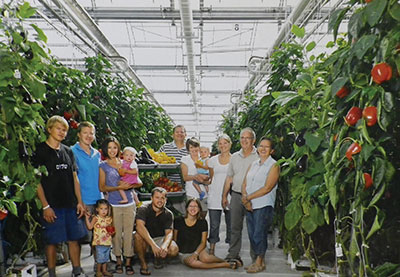
|
INTRODUCING THE FAMILY
Here are the family members at the time this photo was taken, from left to right. (Top photo)
- Hans is now married and has added to the family.
- Paul and Jen, then with two children (and now with three!).
- Phil Visscher (son-in-law) and Coby, seated at front (their four children are not in the picture).
- Eric and Miriam, with one of their four children.
- Elly.
- Joe and Helen.
I finally did find a photo of Phil happily watching his four children (below). This picture was taken during a bus tour of the farm in November 2010.
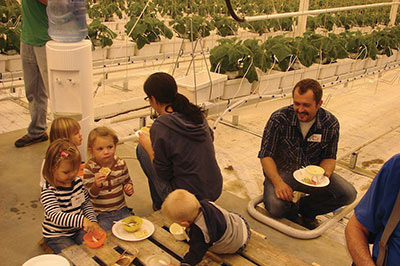
|
Joe told me that he and Helen have been blessed with five children and 12 grandchildren now.
As the family members are getting involved in the business, I asked Joe who does what in the greenhouse.
Eric looks after the computers, public relations and off-shore labour. Eric loves to show me the computer screens and how the temperature and humidity are interacting and how energy is being used. He was a young child when I started visiting the family in the 1980s.
Paul handles most of the labour management duties. He was recently elected treasurer of the Alberta Greenhouse Growers Association, and is also involved with greenhouse safety issues.
Son-in-law Phil Visscher looks after fertilization, bugs and maintenance.
Hans is involved with IPM and the farmers markets.
A CLOSER LOOK AT THE GREENHOUSE BUSINESS
The town of Lacombe in northern Alberta is widely associated with the name Pik-N-Pak Produce Ltd., and Doef’s Greenhouses is one of its members.
I have visited Doef’s Greenhouses regularly since I started as a rookie greenhouse specialist with Alberta Agriculture, Food and Rural Development in 1979.
(I don’t think I called myself both a “specialist” and a “rookie” when I met Joe at his greenhouse early in 1979!)
At our first meeting, I introduced myself and looked around the 18,000-square-foot plastic greenhouse. When Joe asked for my opinion of the crop, I recall telling him that it was one of the best crops I had seen …and it saved me from further questions.
Well, not really, because Joe is always inquisitive. He loves to touch the leaves, the tendrils of cucumbers, and he always knows if a plant is vegetative or generative.
My early visits were at a time when greenhouse vegetables were still grown in soil and Doef’s Greenhouses had steaming units. Growers had to deal with diseases like “damping off” and “ wilts;” surprisingly, the “mildews” were not then a major problem.
While reminiscing about the early 1980s, Joe told me that by the time I had met him and Helen, they had already completed two greenhouse expansions.
In 1970, the greenhouse was a mere 600 square feet – 16 by 36 feet to be exact!
In 1976, it was expanded to 12,000 square feet. It was a Quonset type on a wooden frame and covered with plastic.
During my visits, I also had an opportunity to get introduced to the Doef children, who were often busy carrying hoses and helping pack produce. They are now proud partners in the business.
In 1980, this old wooden structure was replaced by a half-acre metal frame greenhouse, and then a full acre became operational. This expansion was necessitated by expanding market demands, along with disease pressures created by growing in soil.
I recall situations where soil was steamed to control fusarium but it came back with a “vengeance.” That was when we learned, through our well-respected plant pathologist Dr. Ron Howard – who is my mentor and teacher – that fusarium spores can stay on the greenhouse frame, and in nooks and corners, and then settle on the steamed surface … and the infection process would start all over again!
By the time these better structures were being built, soil cultivation was being replaced with soilless methods. Joe has experimented with all sorts of growing media, including sawdust, peat bags, rockwool, perlite, Nutrient Film Technique systems, and has now settled on coir until something better comes along.
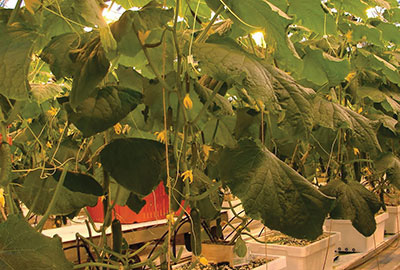
|
In a 2008 photo, (Photo 1, pg 18) perlite was being used in buckets.
The greenhouse was expanded to two acres in 1987, to four acres in 2000, and then to six acres in 2002. Another five acres was added in 2012.
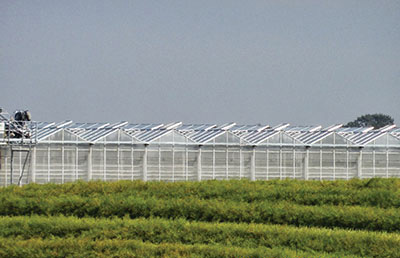
|
This is how it looks from the edge of the road. (Photo 2, pg 18) Crops produced include five acres of English cucumbers, three acres of mini cucumbers, two acres of peppers, a half-acre of tomatoes, along with some eggplants, strawberries and lettuce.
INNOVATIONS ADOPTED AT EVERY OPPORTUNITY
There were many learning curves with the change from soil cultivation to soilless methods, and the Doefs and their staff were eager to adopt the new technologies.
Joe was often the first one to see if technologies could be adopted quickly. The focus was always on produce quality and improved production levels. He made visits to Holland and the information he brought back was quickly applied, adopted or rejected. He will be the first one to invest in and adopt new technologies.
On a 2005 visit to Holland with Joe and other growers, I noticed that he never used a camera and I did not see him taking notes, while I was busily snapping pictures and taking lots of notes. He knew what could be adopted back home in Alberta.
Joe shared the following “firsts’ in greenhouse management and I am a witness to that because I wrote about them in the newsletter and followed these improvements to see how well they worked.
SUPPLEMENTAL LIGHTING WITH WINTER CUCUMBERS
His use of supplemental lights for winter production of cucumbers started in 2008. Electricity prices are constantly monitored and adjustments are made for lighting the crops.
He loves to show the price graphs to see how the price per kilowatt/hour varied during the previous 24 hours, ranging from a few cents to over a dollar. Lights can be turned “on” when the price is the lowest.
The lighting system was built in such a way that 50 per cent of the lights can be turned “on.” Joe showed me how good business decisions can be made after monitoring electricity prices. In one example, the price of electricity between 3 a.m. and 8 a.m. was at $ 0.02/kwh. During the peak hours between 5 to 9 p.m., it was over a dollar.
DIFFUSED GLASS ON THE ROOF
The most recent five-acre range built in 2012 has diffused glass on the roof.
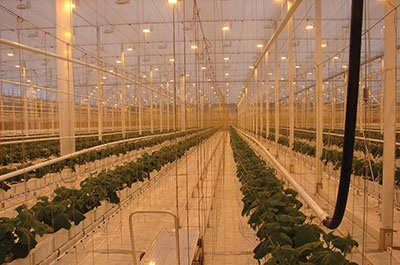
|
|
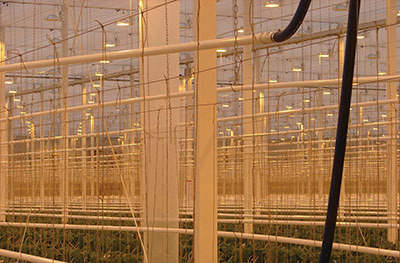 |
These pictures (Photos 3 and 4) show the setup of the newest range. Note the vertical plastic tubes that bring warm air from the top of the greenhouse to crop level.
The greenhouse has blackout screen for lights, and that means that when the lights are on, the surrounding area is not affected with light filtration. This has been a problem reported from Holland and Joe did not want their neighbours to be affected by any possible inconvenience.
Also, in the photo you can see two sets of heat pipes that can be moved as the crop grows. The growing gutter height is also set much like it would be for tomatoes, at about three feet.
Joe notes that cucumbers were grown above ground for several years, then at six to eight inches above ground. Troughs were used and this facilitated leach water collection and recycling. Then, with the greenhouse side walls over 21 feet tall, higher gutters were adopted. The use of grow gutters was adopted earlier in tomatoes.
One also can see the vertical plastic tubes that bring warm air from top to bottom, and this greatly helps to maintain precise environmental controls.
OTHER INNOVATIONS
A heat pasteurizing system replaced the old biofilters. Carbon filters were installed as part of the water management strategy.
Intercropping with cucumbers and installation of double irrigation drippers.
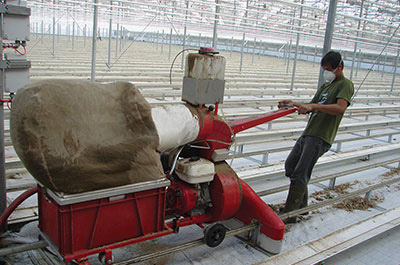
|
A tarp system is used to pull the crop, and a debris vacuum system is used. (Photo 5, page 18) Joe points out that sanitation between crops is very important and this machine effectively removes dead leaves and aborted flowers from peppers. There are fewer challenges in the case of cucumbers because of intercropping.
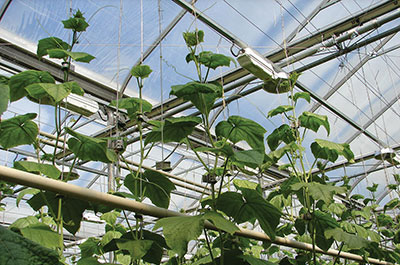
|
|
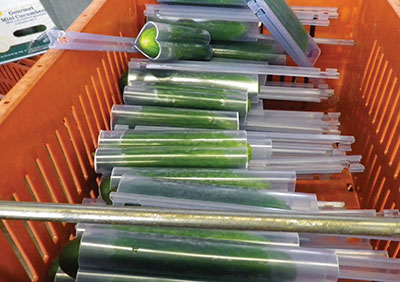 |
The Doefs were the first in the province to use the high-wire cucumber production system, (Photo 6, page 18) and the results are quite impressive. Intercropping was started in 2007. In the photo, Pelikan clips are utilized for high-wire production. The next photo (Photo 7, page 18) shows some of their heart-shaped cucumbers. Growing such distinctively shaped cucumbers is an interesting experience, but it does require more labour. They are grown for special occasions, and consumers love them!
MARKETING THE PRODUCE
Doef’s Greenhouses has always been in a leader in providing high-quality, fresh and locally grown produce directly to consumers in addition to commercial wholesale markets.
Joe loves to do “hands-on” marketing. He and his staff go to five farmers markets and he enjoys it a lot. He is in direct contact with the people who buy his produce and in this way he knows how much the quality of his produce is appreciated.
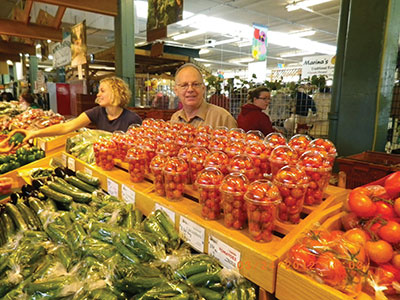
|
|
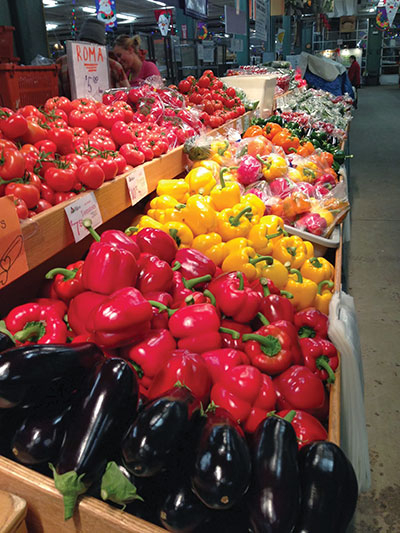 |
I make it a point to visit him in the Edmonton Strathcona Farmers Market once in a while. (Photos 8 and 9, page 18) He loves to explain how fast cucumbers grow. Many markets are now supplied with fresh produce year round and consumers appreciate having a local supply in winter.
There was a time when he was young – not that he is old now – that he spent hours measuring how fast cucumbers grow. By getting up in the very early hours, he finally figured out that cucumbers grow more at night. I was the first to learn from him that from the flower stage, a seedless cucumber could grow into a marketable product in seven days in summer and 14 days in winter. (I have not yet heard from him what effect supplemental lights have on growth rates.)
Pik-N-Pak Produce Ltd. is the packing and shipping company for Doef’s Greenhouses, TR Greenhouses and Gull Valley Greenhouses.
It began with five growers in 1986. I remember when shipping was done from the garage of Paul Prins, one of the growers. It has since evolved into a highly efficient, state-of-the-art packing facility.
In the beginning it was English cucumbers, followed by mini cucumbers, and then different types of tomatoes and peppers were added to the product mix. Packing machines were added accordingly.
Pik-N-Pak Ltd. also has shares in Sunfresh Farms in Edmonton, a major produce marketer.
Eric Doef added that their presence on social media is very important for direct marketing. “We have a large following on twitter – @doefs.” Also popular is the doefsgreenhouses.com website, which is constantly updated.
WILLINGNESS TO SHARE KNOWLEDGE WITH OTHERS
In addition to his success in business, one of Joe’s most remarkable qualities is his willingness to help others. His greenhouse is open to anybody who wants to learn a few things about the industry.
The Doef family has been involved with the Alberta Greenhouse Growers Association since its inception in 1980. Helen and Joe both have served terms on the AGGA board of directors, including terms as president.
Joe takes every opportunity to encourage growers to become AGGA members and promotes the many benefits of membership.
He looks forward to studying potential new greenhouse crops, including okra and strawberries in recent years.
He’s often asked about his cucumber yields. Sometimes he will answer with the total numbers grown, or he will say how many are grown per square metre. Like any business, there are good years and bad years.
With the use of supplemental lights and year-round production came the challenge of insects and diseases. Joe learned that it’s important to stay on top of them and diagnose problems early enough to avoid economic losses.
I have not been able to cover here all that I have learned from Joe.
When cucumbers were produced in soil, he was our number 1 grower. When we heard that growers in Holland had achieved over 200 cucumbers per square metre, I would tell him that I would be retired by the time he reached those numbers. I did retire … but by then he had topped 300 cucumbers per square metre!
And what I love most is that Joe counts his blessings always, and those include family, sunshine, water, good friends, colleagues and fresh produce, of course!
To Joe, Helen and everyone in your family, please keep up the great work. You continue to be major assets to the industry.
Dr. Mohyuddin Mirza is a greenhouse consultant. He would welcome comments at drmirzaconsultants.com.
Print this page